Editor’s note: The National Geographic On Campus event, a unique academic partnership with the University of Miami, kicks off at 9 a.m. Friday at the Shalala Student Center ballroom, the start of a two-day experience that showcases Nat Geo explorers, photographers and videographers, along with UM faculty experts, who will be delivering keynote lectures, panel discussions, and hands-on workshops. The News@TheU team will take you there with continual updates throughout the day. Check back often for the latest updates. Find more information about the event here.
Saturday, Nov. 10 -- On the path of the Florida panther
When most people think of South Florida, they think of turquoise waters and white sand beaches, rolling waves, and coral reefs. While these are all present, many individuals forget to acknowledge the vital ecosystems hidden in the Everglades.
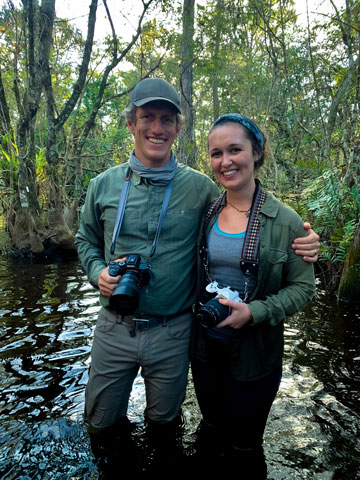
As part of National Geographic’s On Campus seminar, I had the opportunity to spend Saturday learning from National Geographic Explorer and conservation photographer Carlton Ward Jr. The day began when eight other students and I boarded a van with Ward and his camera crew and made the trek west toward the Everglades, the habitat of the elusive Florida panther. Along the way, Carlton spoke about the importance of preserving the Everglades, which is seen as Florida’s last remaining land untouched by development.
As buildings and roadways expand in the Sunshine State, this natural acreage is shrinking. This is threatening the movement of wildlife and limiting many species to smaller habitats. Ward emphasized the fact that he wants to capture compelling photographs to raise awareness about the Everglades and inspire people to preserve what is left of these natural lands. His main focus is on the endangered Florida panther, whose population, estimated as low as 200, is critically threatened by development. Since the species is territorial, the Florida panther requires a large expanse of land to live comfortably and thrive in its natural habitat.
On the way to Southwest Florida, we stopped at a cattle ranch to learn about the role of ranches in the preservation of wild lands. We spoke with the ranch owner who showed us some of her 10,000 acres of grasslands and trees, which is home to 1,000 cattle. She estimated that Florida panthers prey on 5 percent of their cattle annually. However, ranches are one of the only factors preventing development from further invading panther habitat. This shared habitat creates a difficult situation, as the panther depends on ranch land, but as a result, the ranchers face a decrease in economic revenue.
Afterwards, we made a seven-mile drive to the swamplands: a vastly different ecosystem, but one that plays just as vital a role in preserving this merging of wild lands and waterways in Florida. After learning about these ecosystems, we followed Ward into the swamps, treading into waist-deep water where he recounted hours spent photographing these beautiful environments and the unique species residing there. As the setting sunlight filtered through the leaves of the cypress trees above, Ward demonstrated the best techniques to photograph this ecosystem, while speaking about the importance of directly exposing Floridians to these scenes. While many tend to hold a preconceived fear toward swamps — believing they hide alligators and snakes within their murky waters — Ward said it is important for people to learn the beauty they offer and the benefits they serve, such as providing Florida with a main source of fresh water. To encourage protection of these swamps, we must change fear into appreciation, Ward said.
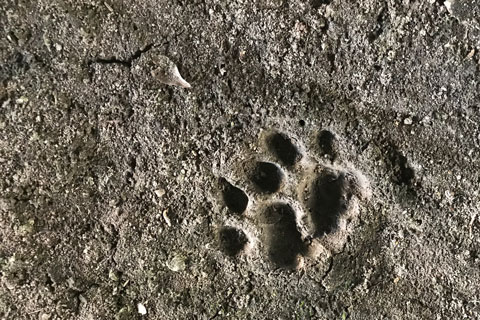 As the sun set, we made our last stop of the day to see how Ward set up his camera-trap systems at wildlife underpasses to photograph the Florida panther in its natural habitat, encroached upon by increasing development (in this case, highways).
As the sun set, we made our last stop of the day to see how Ward set up his camera-trap systems at wildlife underpasses to photograph the Florida panther in its natural habitat, encroached upon by increasing development (in this case, highways).
Throughout the day, we heard from individuals with different perspectives and opinions, all with the common goal of wanting to preserve Florida wild lands and species like the Florida panther. Through storytelling, learning, and direct experiences, we were inspired and unbelievably grateful for the incredible opportunity to engage with National Geographic photographers, journalists, researchers, and explorers, as they dedicate their passions to telling untold stories to bring awareness to the public eye.
-- Emily Green, junior, marine science and biology major
Saturday, Nov. 10 - “Art and Purpose in Photography” with Robin Hammond
On Saturday, many students, like myself, participated in workshops led by a select few National Geographic contributing photographers. “Art and Purpose in Photography” was a workshop led by Robin Hammond, a New Zealand-born photographer known for highlighting human rights issues. Hammond delved into his projects in an intimate classroom setting where students who have followed Hammond’s work were eager to learn more about the beginnings of his career.
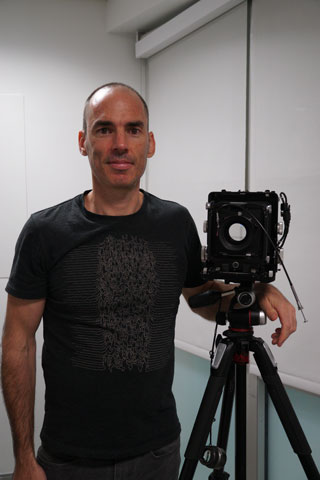
Hammond said he started by working as a freelance photographer out of London and soon after, began photographing marginalized and oppressed people in Africa. He explained how his work took him to Zimbabwe, where he photographed victims of Robert Mugabe’s brutal regime; to Nigeria, where he documented the vibrancy of Lagos, which is Africa’s largest city; and to South Sudan, where he told the story of prisoners whose only crime was suffering from mental health issues. Along his journey, Hammond highlighted the many lessons he has learned and applied in his photographic careers, such as the need for collaboration with locals, or insiders, and the importance of honoring his subject’s difficult stories through informed intent and consent.
“Photography has always been used for change, and the last thing you want to do is impose yourself on your subject,” Hammond said, referring to that fact that some photographers try to influence their subjects with their own opinions or cultural upbringing.
The highlight of his seminar was when he spoke of “Where Love Is Illegal,” an on-going project Hammond has been working on through his non-profit Witness Change. In this project, Hammond documents and shares the stories of LGBTI people from places where identifying as lesbian, bisexual, gay, transsexual or intersex is discriminated, and/or often illegal. Hammond photographs his subjects in a way that makes them feel comfortable and safe, he said. He even chooses to use Polaroid film so subjects who do not like their photograph, can rip it apart for their safety and peace of mind.
Hammond concluded the three-hour workshop with a series of questions that potential photojournalists should ask themselves before embarking on impactful storytelling, such as: “What is my target audience?” and “Is visual storytelling really the best way to do that?” He then shared practical tips for strong photography on topics like lighting, framing and balance. Earlier he had shown the participants how to use his field camera, the camera he used to capture portraits for “Where Love Is Illegal.”
Participants were left with valuable insights on how to effectively tell the stories of disenfranchised and marginalized people—or any subject for that matter—in a way that can “expose [others] to stories they wouldn’t [normally] reach,” Hammond said.
For students looking to go into photography, Hammond said the best piece of advice he had ever received came from another National Geographic photographer, Jim Richardson: “If you want to be a better photographer, stand in front of more interesting stuff.”
-- Diego Ramirez, graduate student in the School of Communication majoring in Intercultural Communications with a focus on political communications
Friday, Nov. 9, 6:04 p.m. - Celebrating the On Campus event with National Geographic
University of Miami President Julio Frenk closed Friday's daylong symposium by thanking the society for its 130 years of “taking down walls and unmasking illusions through storytelling”—and inspiring all of us to make a difference.
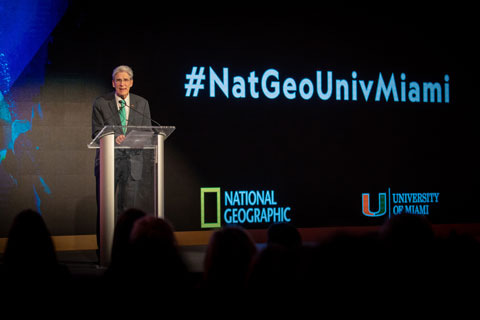 “As our turbulent times have shown us objective facts—the truth—matters,” Frenk said. “National Geographic is the ultimate translator of complex scientific findings into eye-opening and often joyful storytelling. They have opened people’s homes and minds to our vast and celebrated differences and similarities across the globe.”
“As our turbulent times have shown us objective facts—the truth—matters,” Frenk said. “National Geographic is the ultimate translator of complex scientific findings into eye-opening and often joyful storytelling. They have opened people’s homes and minds to our vast and celebrated differences and similarities across the globe.”
And that, Frenk said, was his hope for the more than 1,000 faculty, staff and mostly students who spent all or part of their day looking at science and storytelling through the world-renowned Nat Geo lens. “We want to hear your stories,” Frenk said. “We want you to make a difference in the world.”
Leaving the ballroom for the Explorer Meet and Greet on the Lakeside Patio, freshman Will Huggins was in the same pinch-me-is-this-real mood that seemed to pervade the day. “Where do I begin?” the Hurricanes wide receiver and mechanical engineering major said, when asked his impressions. “I’m passionate about science and the natural world and being among like-minded people who are making a difference gives you hope and inspires you to go do the same thing. It’s infectious.”
-- Maya Bell
5:50 p.m. - Storytellers for change
Storytellers for Change, the last On Campus panel, brought many audience members to tears. Moderated by former School of Communication lecturer and Nat Geo photographer Maggie Steber, four photojournalists spoke about the responsibility of creating a more socially conscience world through effective storytelling and imagery. “Photographers don’t just tell a story, they teach us how to see,” said documentary photographer Daniella Zalcman, a National Geographic grantee who shared her portraits of Indian boarding school survivors. Zalcman, who works out of London and New York, launched her own website and database of female photographers to offer photo editors around the worldF photos taken by women in the male-dominated field.
Kayla Winter, a freshman marine science and biology major, regretted only being able to attend the afternoon session, but said all the panelists, but especially Zalcman, were intriguing. "I never thought about how the majority of photos are taken by men and how that could skew the story, since men are the ones in power in society worldwide, further marginalizing women and enforcing patriarchal views," Winter said. Overall, she said, the panel helped her understand the influence of photos. "Previously, I didn't think of photography as important and this shows how much it could impact others and how it takes skill to know what view you are framing and what the story could tell."
UM School of Communication Professor Sanjeev Chatterjee; Neil Losin, biologist and filmmaker; and Robin Hammond, documentary photographer, also participated in the panel. Hammond, creator of "Where Love Is Illegal," traveled to 14 countries to capture the stories of people whose lives are imperiled because they identify as LGBTQ+. One of his stories was Nat Geo’s first cover story featuring a transgender person.
Laura Lopez Ramos, communications specialist for the Graduate School, was personally affected by Hammond's project. “To see his perspective on how important it is to be an ally and to fight for those who don’t have a voice made me feel like maybe I should start fighting," said Lopez, who has a loved one who identifies as transgender.
-- Ashley A. Williams
5:09 p.m. - ‘Embrace your passions and share your stories’
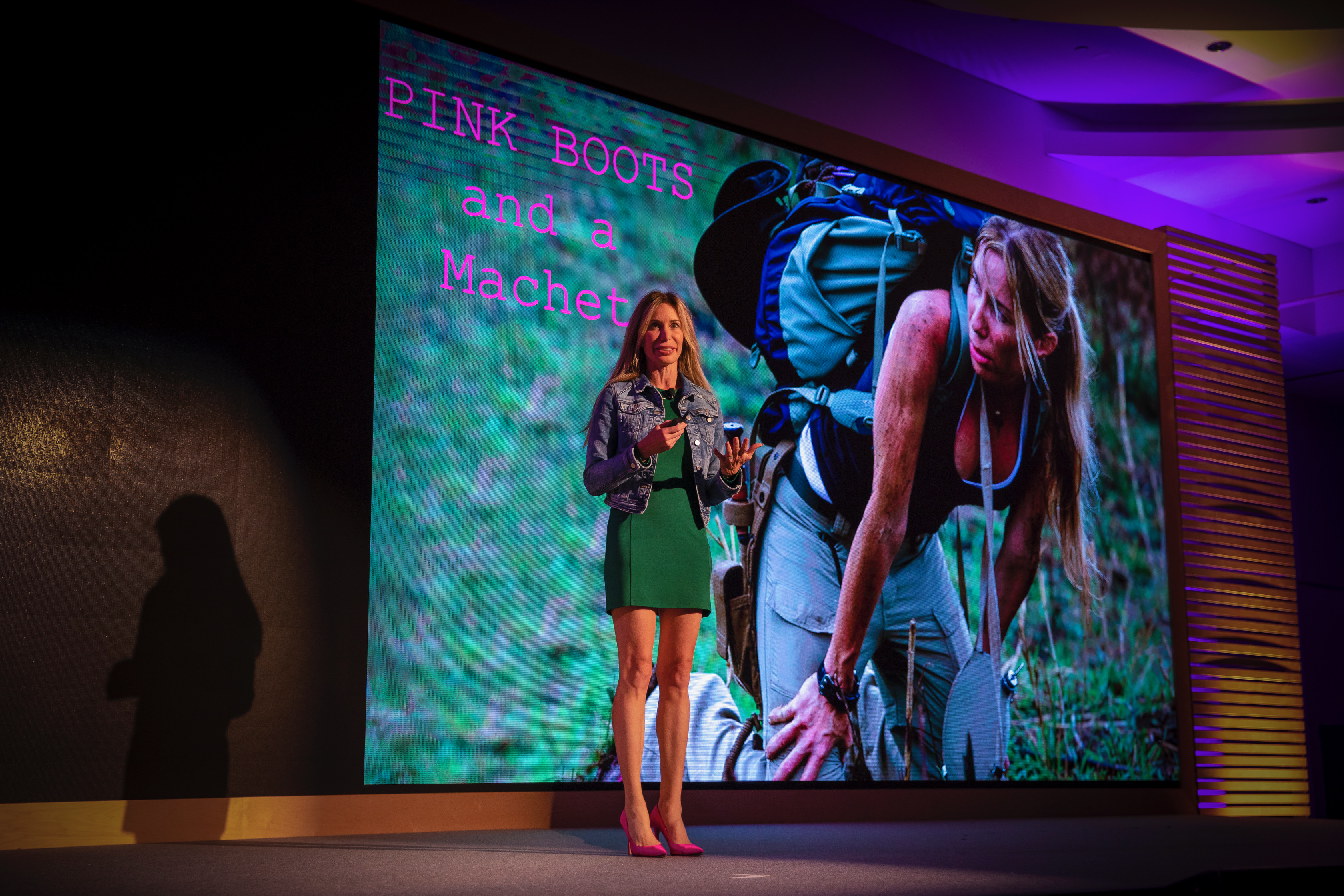
As a little girl growing up in Miami’s Little Havana, Mireya Mayor kept lizards and all kinds of other “critters” in shoeboxes under her bed, prompting her Cuban-born mother to scream whenever she would find them. “My house was basically a zoo,” Mayor recalled. “I climbed trees and was always curious about animals.” Now a renowned primatologist and anthropologist, the UM alumna shared her journey from overprotected youngster to fearless wildlife explorer during Friday afternoon's keynote address.
“I didn’t have opportunities like other explorers,” she said inside the Shalala Student Center, referring to scientists who grew up in what she described as the “green world.” She wasn’t good at math, and her mother refused to let her join the Girl Scouts, telling her daughter it was too dangerous. But when Mayor enrolled in an anthropology course at UM to satisfy a science requirement, her life changed. The work of legendary primatologists Dian Fossey and Jane Goodall captivated the young Mayor, inspiring her “to want to go out into the field” to study primates. And what a ride she’s had. She’s been chased by a stampeding elephant, forced to ingest leaves to calm down a 350-pound silverback gorilla, and bitten by poisonous insects.
It was all in the name of discovery, of course, and Mayor, a Nat Geo explorer who’s been described as the female Indiana Jones, has never regretted it.
As a graduate student in Madagascar, she studied the silky sifaka, collecting blood and tissue samples of the rare lemur and creating a genetic profile of the species. National Geographic produced a film on her research and was so impressed with Mayor that it invited her to become its first female wildlife correspondent. For the past 17 years she’s hosted a multitude of Nat Geo programs all over the world, diving with an especially aggressive species of great white sharks in one instance. In Namibia, she encountered a farmer who cared for an unusually docile pair of leopards. Something had to be wrong with the big cats, she surmised. So she and the farmer took them to a local veterinarian for a CT scan, which revealed they were suffering from hydrocephalus, a condition that typically affects humans and is caused by an abnormal build up of fluid in the cavities of the brain. But the farmer didn’t give up on the leopards, and after several weeks of caring for them, they improved. A second CT scan showed no trace of the fluid, and the leopards “started acting like cats,” Mayor said. Now, in effort to treat humans for the condition, research is underway that delves into duplicating some of treatment efforts initiated by that farmer.
“That’s the power you can have,” Mayor, sporting pink stilettoes, said Friday.
-- Robert C. Jones Jr.
-- Photo: Michael Montero
4:50 p.m. - Comments by panel for 'Stories of Memory and Place'
Patricia Saunders, University of Miami associate professor of English, Hemispheric Caribbean Studies Faculty lead, introduced three National Geographic grantees who have worked covering issues of migration and cultural identity.
Dominic Bracco, a photographer and transmedia storyteller, showed many of his poignant pictures of the Mexico/Texas border, where he grew up. He talked about the history and fluidity of borders, which can be both physical and personal. In his own family, he said, relatives were coyotes, or human traffickers, and others members of ICE, the Immigration and Customs Enforcement Agency. For many Americans, he said, there is a huge problem in talking about the border because they do not understand its history, how it was created, and what it means. “It is part of a great myth,” he said. “A myth that the American West was open for the settlement of white families and that Mexican immigration to the United States was unprecedented.” Through his work, he has realized that “a border is more of a connecting force than a wall.” It is a space defined by shared histories, from people on both sides, who often are marginalized and not represented politically.
Anthropologist Valentina Glockner, presented a project she participates in with eight other researchers, geographers, and photographers on Child Immigration Experiences in the Americas. The decade-long project documented the flight of children crossing the entire Latin American continent. She showed an animated short film about two young children she met, Fifa and Maribel, who crossed the desert with their parents. While in transit, Fifa is bitten by a scorpion and left for dead after he faints. His mother and sister were forced to leave him. Fortunately, Fifa awakens and is able to join the group of migrants. Glockner heard the story from the children themselves, once they had arrived to the U.S., and they urged her to share their story so others could learn from their experience. She hopes the project will give children a voice. “We often think of these kids as passive actors and helpless victims of reckless and abusive adults,” she said. “What we want to stand for and want the world to know is that children are fundamental constructors and shapers of mobility in the American continent.” She also said border policies that risk the lives of migrant children test the limits of our human rights and decency.
Erika Larsen, a photographer and transmedia storyteller, documents cultures that have close ties to nature. In a special assignment from National Geographic, she was able to document the work and lives of the Yupik people in Alaska who are reclaiming their traditions and culture by rebuilding an archeological site that served as their ancestors living and gathering space. As each artifact is unearthed from the ancient site, members of the Yupik people use them as learning tools to keep their traditions alive and relevant, she said.
Junior Rachel Sandquist said she "liked how the panel represented a more humanitarian approach to the world. I didn’t know the effect on a child crossing the border and how alone they are for most of the process.”
-- Barbara Gutierrez
3:26 p.m. - 'Stories of Memory and Place'

Patricia Saunders, associate professor of English, moderates a panel that included Erika Larsen, photographer and Nat Geo Fellow; Dominic Bracco II, photographer and Nat Geo grantee; and Valentina Glockner, anthropologist and Nat Geo grantee.
Saunders, the lead faculty member for the Hemispheric and Caribbean Studies program, said Miami is a perfect place for National Geographic to start their On Campus initiative because it has such biological and cultural diversity. "Bringing this to the University of Miami reminds students, particularly from where they are in their own academic programs and their different backgrounds, of the importance of storytelling," she said. "It's a unique opportunity to take all of what they learned in the classroom and to think about real-life applications."
-- Photo: Michael Montero
-- Janette Neuwahl Tannen
3:15 p.m. - Wildlife beyond borders
Rachel Bale, an investigative reporter with National Geographic who often writes about how borders affect wildlife, introduced four experts who are increasingly aware of the dangers that these lines represent.
Krista Schlyer, a conservation photographer and writer, spends time documenting the wildlife and people affected by the push to construct a permanent wall between the United States and Mexico. Schyler explained that this area is a major source of biodiversity because it contains the Lower Rio Grande Valley —a major flyover point for bird species that commute between North and South America—and the Chihuahua desert, which is one of the last remaining grasslands in North America. Schlyer is now working on a documentary that sheds light on the massive butterfly populations that exist and breed in the region.
Jamal Galves is a program coordinator and research biologist for Sea to Shore Alliance in Belize, which works to study and protect manatees. Galves met his supervisor, a researcher, when he was just 11 years old and saw his truck passing his grandmother’s house daily. He asked to tag along and now tries to foster relationships with countries that surround Belize to raise awareness about conserving manatees, studying them and how to properly rehabilitate the animals if they are injured by boats. He works with representatives from Cuba each year to help spread awareness about the need to protect the gentle creatures. "We don't live in a bubble... and we need to think of ourselves as one country, one world, and one people to combat these [environmental] problems," he said.
Juliana Machado Ferreira is executive director of Freeland Brazil, an organization that works to conserve biodiversity in the region by combating wildlife trafficking. Ferreira outlined many of the reasons that people poach and traffic animals, such as for fashion or pharmaceutical research, or for fancy purses, or exotic pets. She also described how moving these animals outside of their natural habitats can be extremely harmful to their reproductive abilities, as well as their ability to survive in different climates and environments. In addition, Ferreira said that introducing an invasive species (such as the way that Burmese pythons have overtaken the Everglades), can also harm the biodiversity of an area. But she acknowledged that it is difficult for governments to catch these traffickers. “Wildlife trafficking is a threat to biodiversity, as well as our economy and security and governance and it’s up to us to stop it,” she said.
Natalie Barefoot, a UM School of Law professor who specializes in climate change and the protection of whales, dolphins and porpoises, spoke about how whales and oceans absorb carbon created by humans and, therefore, help maintain healthy air across the world. However, Barefoot noted that with the increase in temperatures caused by climate change, whale migratory patterns may change and their food sources could be threatened, so it is important to do everything possible to prevent climate change from affecting our oceans even more. “If we have a healthy and robust population of whales, we will be mitigating climate change problems,” she said. “It’s not just an environmental issue, but a public health issue, so we need to encourage and demand from our leaders that they address this, and we must take individual responsibility as well.”
Karen Shedlock, a junior from Virginia, said she was overwhelmed by the panel. “As a student of marine biology, I thought I had a good handle on a lot of stuff but so much of the information was new to me—and scary. I never even considered that the wall would disrupt habitats,” she said.
-- Janette Neuwahl Tannen
2:56 p.m. - Sustainability factor
Biodegradable food containers, cups, and utensils; recyclable name badges and branding totems; and reusable silicon-based wristbands. The sustainability initiatives featured at the inaugural National Geographic on Campus go hand in hand with the pressing global problems being discussed by explorers and scientists during the two-day event. “The link is clear,” said Teddy L’Houtellier, sustainability manager for environmental health and safety at UM. “We’re living in a world with an enormous problem—plastics polluting our oceans and plastic micro particles showing up in fish around the world.”
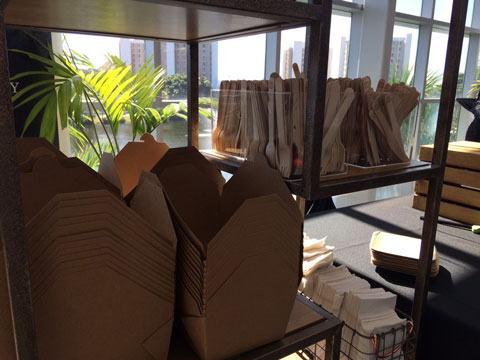 Just how serious is the problem? Consider: Each year, billions of pounds of plastic end up in the world’s oceans. The synthetic material is so durable that nearly every bit of plastic ever made still exists, some environmental groups have reported. In between Friday's talks, L’Houtellier said it is an “alarm that we need to heed. But it’s not easy because plastic is everywhere.”
Just how serious is the problem? Consider: Each year, billions of pounds of plastic end up in the world’s oceans. The synthetic material is so durable that nearly every bit of plastic ever made still exists, some environmental groups have reported. In between Friday's talks, L’Houtellier said it is an “alarm that we need to heed. But it’s not easy because plastic is everywhere.”
UM, he said, has a Disposal Plastic Free Campaign that provides tips on how to limit the amount of plastic on campus and in the environment. He also noted that the University was one of the first businesses in Coral Gables to comply with the city’s recent ordinance prohibiting the use of singe-use carryout plastic bags at retail establishments. “All our vendors are happy about it,” he said. UM’s retail outlets now use paper bags. “Paper also has a carbon footprint, but we have a composting site on campus where all food waste, branches, and paper can be dropped off and converted into soil,” explained L’Houtellier. “There’s a smart way to get rid of your paper bags.”
During the Nat Geo event, “we’re using literally thousands and thousands of wooden eating utensils,” said Wendy Franklin, director of catering for Chartwells, the food service vendor for UM. National Geographic also has an initiative to sound the alarm about plastic. Launched last May, its Planet or Plastic? Campaign is a multiyear initiative aimed at raising awareness to reduce the amount of single-use plastic that enters in the world’s oceans.
-- Robert C. Jones Jr.
2:32 p.m. - An eco-friendly lunch and student reaction
After a morning of panels discussing pressing global issues, such as the protection of animals and their habitats, hundreds of attendees filed out of the ballroom for a plastic-free lunch as the Frost Laptop Ensemble serenaded the crowd.
Each year, an estimated 18 billion pounds of plastic waste enters the world’s ocean from coastal regions. Which made providing the eco-friendly lunch an easy decision. Provided by the UM catering company In Style by Chartwells, in partnership with the Office of Sustainability, today’s lunch menu featured many products locally and sustainably grown. Participants enjoyed salad, maraquitas, and various protein options on bamboo plates and utensils. The purpose is to help reduce the waste generated at events as much as possible. The eco-friendly touch perfectly aligns with National Geographic’s new Planet or Plastic? Campaign.
“I think it's cool that our university is encouraging that,” said Rebecca Goddard, a sophomore majoring in motion pictures. “It shows that they care about student engagement and protecting the Earth at all costs.”
-- Ashley A. Williams
Diego Ramirez, a communication graduate student and Miami native, said he came to the symposium as an avid photographer and a reader of National Geographic magazine. "I've always been a fan of National Geographic and their ability to tell stories around the world, and bringing the public eye to anything going on good or bad, so I wanted to be a part of that."
Second-year law student Michael Harder said he enjoyed the session on Florida in 2100 because the panelists talked about their environmental interests from a broad perspective that was understandable to the audience. “Also, they mentioned what we can do on an everyday basis about these issues and to see that is important too,” said Harder, who plans to go into real estate law.
Kristen Ranges, also a second-year law student, said she loved the way science photographer Anand Varma combined his explanations of coverage with multimedia in the background to engage symposium participants. “I liked how he combined the photos with techno music in a video and showed that if you modernize your work in a non-traditional way it can get the attention of more people.”
-- Janette Neuwahl Tannen
2:07 p.m. - Inside the ballroom
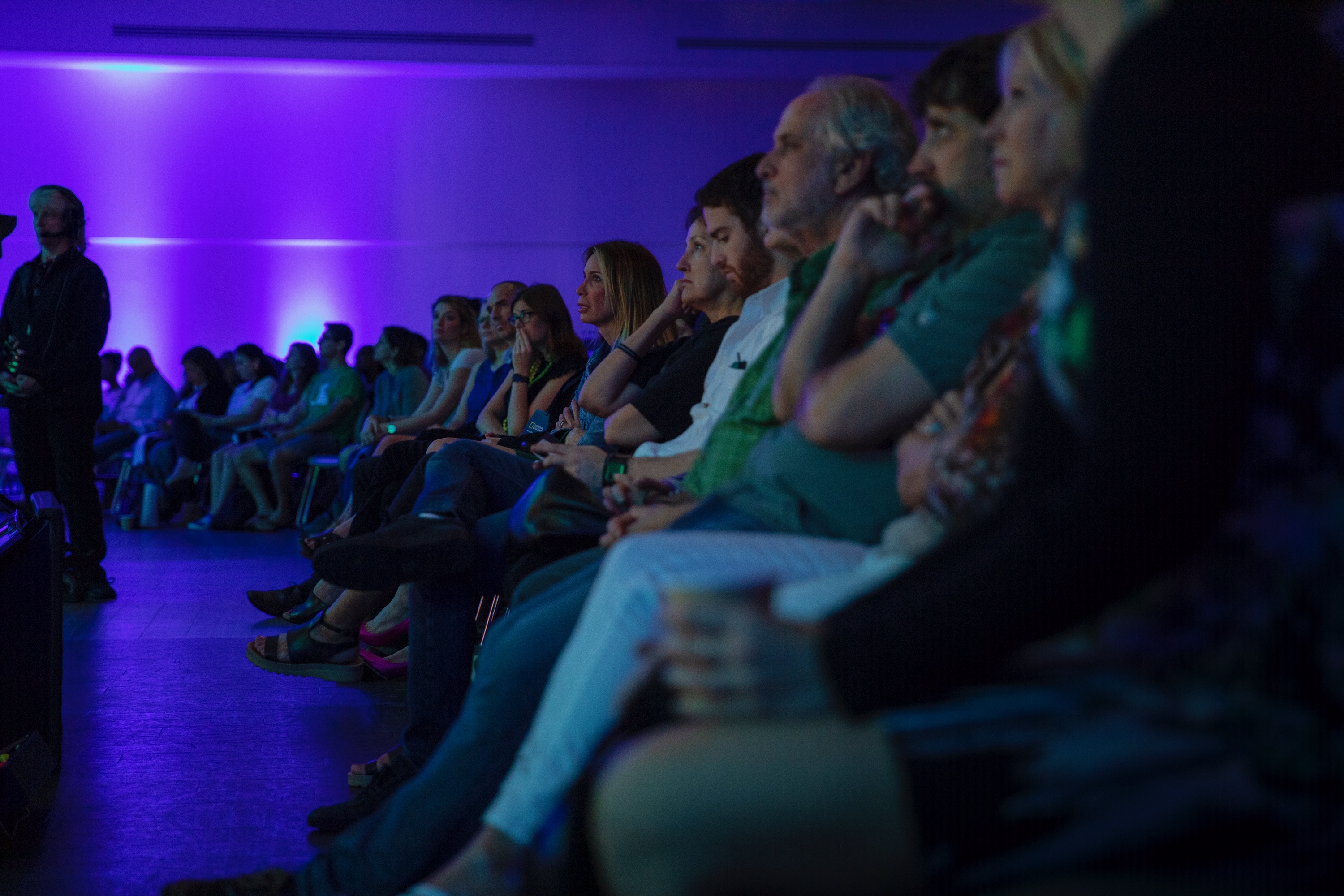
-- Photo: Michael Montero
1:35 p.m. - What will Florida look like in 2100
Robin Bachin, assistant provost for civic and community engagement, introduced a series of National Geographic speakers who each shared how they believe the state could be transformed in the future. “They will show us a way in which storytelling can convey important environmental issues,” she said.
Jenny Adler, a conservation photographer, spoke about the importance of taking care of Florida’s fresh water reserves. “We need to see our water as an ecosystem rather than a resource. We need to give students a voice and help them engage in subjects and get them excited about telling these complex stories,” she said.
Rachel Silverstein, executive director for Miami Waterkeeper, took the audience down memory lane, displaying photos of what Florida looked like 100 years ago. One photo in particular showed barren land where Lincoln Road in Miami Beach now thrives. It gave the audience perspective on how rapidly the state is evolving. “Ecosystems evolve and change. It’s important to keep in mind where we came from. It’s up to all of us to make sure the future is bright and Florida is the place to be in 2100,” added Silverstein.
Carlton Ward Jr., who is a conservation photographer, highlighted how overpopulation is negatively affecting wildlife. Every year over 100,000 acres are being transformed into housing projects. He projects that in 2060, a great deal of the Everglades will be cut off due to increasing development. His goal is to raise awareness by capturing powerful photographs of land that needs to be preserved to save Florida’s endangered species. He said that only 200 panthers remain in the state, and their habitat needs to be preserved for them to survive.
Barrington Irving, who broke the Guinness World Record for being the youngest man to fly solo around the world, brought up a fascinating point about how technology is going to influence the way we live in Florida. Overpopulation in the next decade is spurring ride-sharing applications to think of ways to combat traffic. Irving showcased a video from Uber displaying plans to use helicopter-like planes to help people get people around cities like Miami.
Students were greatly impacted by all the speakers.
“I thought it was really interesting how they brought in a bunch of different perspectives. I really enjoyed how they spoke about solving congestion in the future. It was great to see how multifaceted the panel was,” said Paula De Silva, a sophomore majoring in microbiology and immunology.
-- Amanda M. Perez
1:15 p.m. - Sights and sounds from On Campus event


-- Photos: Michael Montero
1:05 p.m. - Imagine Nat Geo without photography
Serving as Master of Ceremonies, Kenny Broad, an intrepid underwater cave diver and National Geographic’s 2011 Explorer of the Year, conveyed his joy at seeing a packed ballroom. “Wow,” he gushed. “I didn’t know students woke up before noon.” Broad, director of UM’s Abess Center for Ecosystem Science and Policy, said he was thrilled to merge the UM and Nat Geo communities, particularly because “facts can only get you so far” and “we make decisions based on our emotions.”
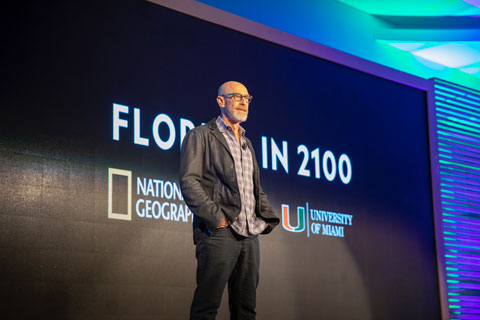
And Nat Geo, of course, is the master of tapping into our emotions by mirroring our world in photos. Stunning, breathtaking, uplifting, and heartbreaking photos. But, believe it or not, Nat Geo’s Michael Ulica said the first photos the venerable magazine published 17 years after its 1888 debut caused an uproar and a rebellion. Some board members resigned, thinking the scientific journal wouldn’t be taken seriously.
Today, journalism student Casey Chu couldn’t imagine the magazine, which he subscribes to, without photos. A former paralegal who gave up his career to tell stories to a broader audience—most juries only have six people, he noted—he “was delighted Nat Geo picked UM to nurture the next generation of writers, photographers, and scientists who will inform the public about the word’s most pressing problems. That’s why I came here—for these kind of incredible connections,” Chu said.
-- Maya Bell
12:05 p.m. - Raising environmental awareness
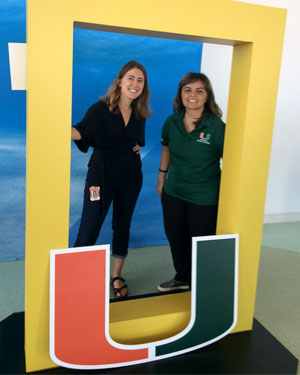 A free diver who has explored coral reefs in the Florida Keys and off the coast of Miami Beach, Amy Parvis has always been concerned about global warming and the rate at which rising temperatures are threatening these magnificent underwater ecosystems. So when she learned that National Geographic would be launching a new nationwide educational program of symposia at UM, the senior administrative assistant in the Office of Faculty Affairs wasted no time in signing up for some of the science and storytelling seminars that would be presented during the two-day event.
A free diver who has explored coral reefs in the Florida Keys and off the coast of Miami Beach, Amy Parvis has always been concerned about global warming and the rate at which rising temperatures are threatening these magnificent underwater ecosystems. So when she learned that National Geographic would be launching a new nationwide educational program of symposia at UM, the senior administrative assistant in the Office of Faculty Affairs wasted no time in signing up for some of the science and storytelling seminars that would be presented during the two-day event.
“Global warming is the most important issue we’re facing today,” Parvis said as the event kicked off early Friday. “I’m always looking for opportunities to learn more about our environment, and this Nat Geo event is a great way to do that.”
Parvis and her boss, Director of the Office of Faculty Affairs Cecelia Smith, both attended Friday morning’s keynote address by American photographer Anand Varma, then posed for a photo that featured two iconic symbols—the familiar yellow border National Geographic adopted in 1910 and the ubiquitous U symbol of the University of Miami. Said Parvis, who subscribes to National Geographic magazine: “This entire event should do wonders for helping to raise environmental awareness.”
-- Robert C. Jones Jr.
11:55 a.m. - A student's takeaway
Paisley Freund, a graduate student in the Miami Business School, came away inspired by the first presentation by Anand Varma, a science photographer and National Geographic Fellow whose first feature story and cover for Nat Geo—"Mindsuckers"—was published in November 2014. "It's amazing how they can capture something that seems simple and make you want to dig deeper," Freund said. As a documentarian, she wants to be able to do that with her work.
-- Barbara Gutierrez
11:53 a.m. - Keynote by Anand Varma
In the first speaking session, photographer Anand Varma, who lives in Berkeley, California, described his passion for making complicated scientific research on animals accessible to readers and viewers of National Geographic. This began when he was a student at the University of California—Berkeley studying integrative biology. Using photos to illustrate his journey from getting a National Geographic Young Explorer grant to publishing his first cover story in 2014, Varma talked about several different projects he did where he examined how a host animal can be completely manipulated by its parasite. First, he detailed his experience trying to showcase a worm that invades crickets in New Mexico, eventually causing the cricket to drown itself so that the parasitic worm can survive.
“I needed to find a way to get compelling images of a viscerally uncomfortable situation,” Varma said, adding that after 28 days and 3,000 images, he succeeded in getting the photo he wanted.
Varma showed his captivated audience a time-lapse video of all the 3,000 images that demonstrated his nearly month-long journey. He also showed a second project where he captured a ladybug that is invaded by a certain wasp that forces the bug to protect its new “child.” The stunning photo of a ladybug cradling its stomach later became a cover image for National Geographic Magazine. Varma also explained two more projects about a crab whose parasite has the ability to change its sex, and a frog that is forced to grow extra legs by a flatworm parasite. Last, Varma showed images of a project he did where he wanted to detail the current situation of honeybees that are struggling to exist with rampant pesticide use. To accomplish this, Varma visited labs at the University of California—Davis, and at the University of Pennsylvania, to learn about the bee’s difficulties. “Pesticides disrupt their ability to remember where their food is,” he said. Ultimately, Varma raised his own bees in his backyard for 21 days, following their journey from a larva emerging through a honeycomb, to a mature bee.
Last, Varma showed a dramatic video of a project he did on hummingbirds, detailing their aerodynamic strength with photos of them fluttering off water, and also how scientists study their speed by using smoke to visualize their wing strength. “You need to figure out a way to show this research to capture people’s attention who wouldn’t normally care,” Varma said. “That’s the value of storytelling — to connect people with what you care about.”
-- Janette Neuwahl Tannen
11:33 a.m. - Showcasing the iconic looks
Claire Griffin and Emily Green, both marine science and biology majors.
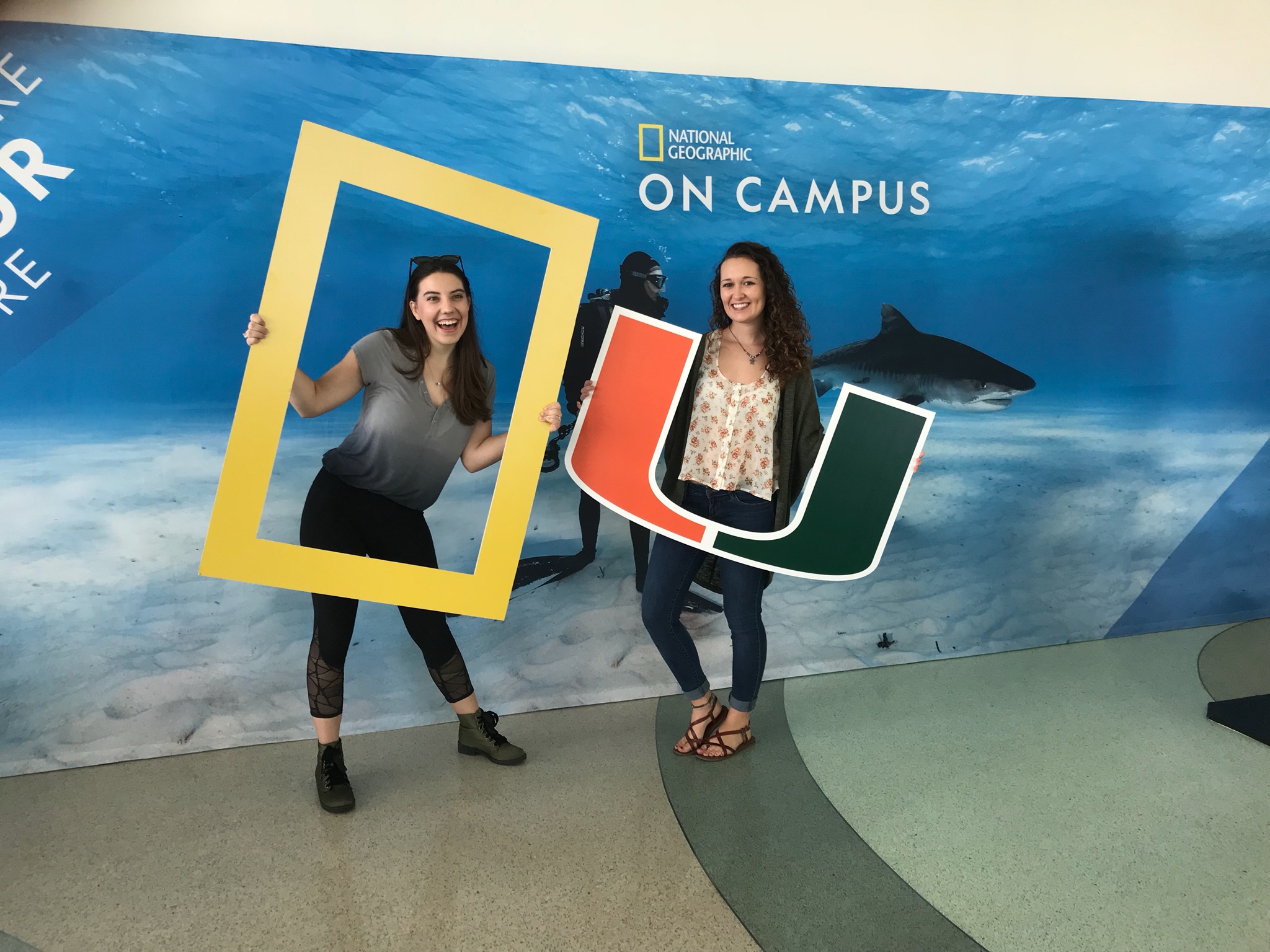
11:25 a.m. - Nat Geo and UM intertwined
As the symposium got underway, the excitement was palpable inside the ballroom at the Shalala Student Center, an almost pinch-me-I-can’t-believe-this-is-real feeling that the most recognized brand for exploration, science, and storytelling chose UM for its inaugural On Campus initiative aimed at inspiring the next generation of changemakers who will shoulder the ever-growing challenges of a changing planet.
But National Geographic's iconic yellow frame that has bordered its magazine for more than a century and the University’s split U are, Michael L. Ulica, Nat Geo’s executive vice president, told the audience of mostly students, a perfect match that dates to both institutions' shared history and vision for the future. After all, he noted, Gilbert H. Grosvenor, who became the magazine's first full-time editor in 1899 and served as the society's president for 34 years, was a member of UM’s Board of Trustees. Grosvenor was also a frequent visitor to the marine lab that would evolve into UM’s renowned Rosenstiel School of Marine and Atmospheric Science.
Ulica, who credited UM’s environmental anthropologist and Nat Geo explorer Kenny Broad for the NatGeo/UM partnership, said he’s often asked to name the best and most exciting places he’s visited, and his answer is always the same: “Anyplace I get to spend time with the next generation of leaders.” And to inspire them, he announced another first for the society: it will award three $5,000 scholarships to three UM students for science, storytelling, and education—the society's first college-specific awards. “We want you to be both innovators and explorers, no matter what field you pursue,” he said. “Working together we will achieve a planet in balance.”
It was the marine school’s programs that attracted marine science and biology majors Emily Green and Claire Griffin to UM in the first place and on Friday, the wisdom of their choice was reaffirmed. “We’re both super-passionate about the environment,” Griffin said, “and it made me feel super grateful that Nat Geo and the University are partnering to help us bring digestible science to the public."
-- Maya Bell
11:09 a.m. - Making new friends at On Campus event
While munching on their breakfast before the keynote, students Sylvia Forsyth, a senior entrepreneurship and art major, and Daisy Buzzoni, a Marine Science and Ecology graduate student, were getting acquainted.
Although she is not a marine science major, Forsyth, a native of Saint Louis, Missouri, said she loves participating in marine cleanups and often goes snorkeling on the weekends in Miami, so coming to the National Geographic symposium was a natural choice in between classes. "I'm a marine life fanatic and I wanted to be here to see some very well-informed people speak," she said, adding that if she does go to graduate school her studies will focus on marine life.
Buzzoni, who works in the Coral Reef futures lab at the Rosenstiel School of Marine and Atmospheric Science, said she is interested in coming to the panels to see how science can be communicated better to the general public. "I'm interested in communicating scientific research and conservation issues with the public, and I'm also a fan of underwater photography, so I'm excited to hear about all that.
-- Janette Neuwahl Tannen
9:25 a.m. - Let's get started
Registration is open for the On Campus event, and the third floor at the Shalala Student Center is buzzing in anticipation of today's discussions. The columns in the hallway are wrapped with beautiful photos and imagery that National Geographic is known for. Michael Ulica, chief financial officer and chief operations officer for the National Geographic Society, will present opening remarks at 10 a.m.
-- Megan Ondrizek

-- Photo: Michael Montero

